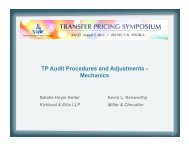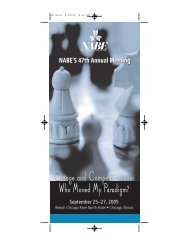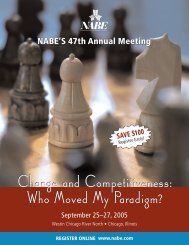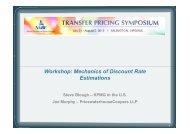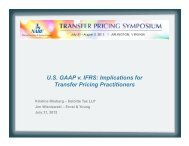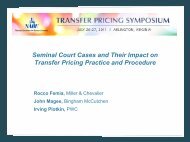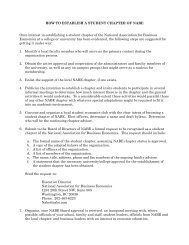An Econometric Analysis of Consumer Sentiment and ... - NABE
An Econometric Analysis of Consumer Sentiment and ... - NABE
An Econometric Analysis of Consumer Sentiment and ... - NABE
- No tags were found...
Create successful ePaper yourself
Turn your PDF publications into a flip-book with our unique Google optimized e-Paper software.
<strong>An</strong> <strong>Econometric</strong> <strong>An</strong>alysis <strong>of</strong><strong>Consumer</strong> <strong>Sentiment</strong> <strong>and</strong>Confidence Indexes: PullingTrigger EffectsbyChris G. Christopher, Jr.July 1, 2011
<strong>An</strong> <strong>Econometric</strong> <strong>An</strong>alysis <strong>of</strong> <strong>Consumer</strong> <strong>Sentiment</strong> <strong>and</strong> Confidence Indexes:Pulling Trigger EffectsWe <strong>of</strong>fer an overview <strong>of</strong> IHS Global Insight's econometric research on the determinants <strong>of</strong> consumer mood, usingtraditional explanatory variables such as gasoline prices, initial unemployment insurance claims, the unemploymentrate, <strong>and</strong> equity prices.In this special report, we <strong>of</strong>fer an overview <strong>of</strong> IHS Global Insight’s research on the determinants <strong>of</strong> consumer attitudesusing traditional explanatory variables as well as psychological “trigger points” from the field <strong>of</strong> behavioral economics.In addition, we give a brief overview <strong>of</strong> behavioral economics. In subsequent articles, we will focus on thedeterminants <strong>of</strong> inflationary expectations <strong>and</strong> Bloomberg's weekly comfort index. Since this report is somewhattechnical <strong>and</strong> lengthy, we have also provided a relatively brief summary as a perspective article: <strong>Consumer</strong> Feelings<strong>and</strong> Economic Reality, by Chris G. Christopher, Jr. (June 6, 2011).The Conference Board's consumer confidence <strong>and</strong> Reuters/University <strong>of</strong> Michigan’s consumer sentiment indices aretwo widely used measures <strong>of</strong> consumer attitudes <strong>and</strong> the factors that drive consumer spending. Personalconsumption represents approximately 70% <strong>of</strong> GDP <strong>and</strong> is a key component in our underst<strong>and</strong>ing <strong>of</strong> business cycles.IHS Global Insight’s large-scale quarterly U.S. econometric model forecasts <strong>and</strong> utilizes the Reuters/University <strong>of</strong>Michigan's consumer sentiment headline <strong>and</strong> short-term inflation expectations indices. <strong>Sentiment</strong> is a driver forvarious inflation-adjusted consumer expenditure components. Inflation expectations affect interest rates, wage rates,<strong>and</strong> the rental cost <strong>of</strong> capital.First, we give a brief overview <strong>of</strong> the current state <strong>of</strong> behavioral economics in the overall context <strong>of</strong> “mainstream"economics. We then discuss the econometric models <strong>and</strong> data used, <strong>and</strong> outline our key findings. Finally, we <strong>of</strong>fersome brief conclusions.The Homo Economicus Assumption <strong>and</strong> Behavioral EconomicsMost modern mainstream economics analysis assumes that individuals behave as Homo Economicus (EconomicHuman). In this analytical framework, individuals behave under a narrowly defined “rationality” with purely selfinterestedmotives, where economic agents are strict “utility” maximizers with not much consideration <strong>of</strong> social,cognitive, or emotional factors in the underst<strong>and</strong>ing <strong>of</strong> human actions. Mainstream economists (Neo- or New-Keynesian, Classical, Neo-Classical, etc.) assume Homo economicus as the starting point in developing theirrespective theories <strong>and</strong>, in most cases, do not consider it necessary to challenge or empirically test this vital <strong>and</strong>highly restrictive assumption. Most other social sciences, however, such as anthropology, sociology, psychology,behavioral sciences, <strong>and</strong> nonmainstream economics, have rejected the concept <strong>of</strong> Homo economicus. There isconsiderable agreement that human actions are rational in many circumstances, but not to the extreme <strong>of</strong> Homoeconomicus—there has to be room for emotions, <strong>and</strong> spontaneous innate urges.The two major nonmainstream economic schools <strong>of</strong> thought—Keynesian/Post-Keynesian (M. Keynes, HymanMinsky) <strong>and</strong> Austrian (Karl Menger, Ludwig Von Misses, F. A. Hayek)—diverge on economic policy prescriptions, butagree that the assumption <strong>of</strong> Homo economicus is erroneous <strong>and</strong> lead to ineffective policy prescriptions. According toJohn Maynard Keynes' The General Theory <strong>of</strong> Employment, Interest <strong>and</strong> Money, "[...] <strong>of</strong> our decisions to dosomething positive, <strong>and</strong> the full consequences <strong>of</strong> which will be drawn out over many days to come, can only be takenas a result <strong>of</strong> animal spirits—<strong>of</strong> a spontaneous urge to action rather than inaction, <strong>and</strong> not as the outcome <strong>of</strong>weighted average <strong>of</strong> quantitative benefits multiplied by quantitative probabilities."[2].1 IHS Global Insight Published 7/1/11
The relatively new <strong>and</strong> developing fields <strong>of</strong> behavioral <strong>and</strong> experimental economics, evolutionary psychology, <strong>and</strong>neural sciences <strong>of</strong>fer valuable insights <strong>and</strong> scientific evidence as to the behavior <strong>of</strong> individuals in the context <strong>of</strong>human action. While these fields <strong>of</strong> research <strong>of</strong>ten disagree with each other on the reasoning <strong>and</strong> conclusionspertaining to human behavior, they find common ground in their rejection <strong>of</strong> Homo economicus <strong>and</strong> provideconfirmation to the analytical framework developed by the classical “liberal” tradition <strong>of</strong> the 19th century <strong>and</strong>exemplified in the works <strong>of</strong> Hayek. The field <strong>of</strong> behavioral <strong>and</strong> experimental economics has made significant inroadsinto the mainstream economics establishment, while several pioneers in the field have been awarded the NobelMemorial Prize in Economic Sciences. Behavioral economists attempt to empirically define the limits <strong>of</strong> humanrationality as being bounded <strong>and</strong> not without limits.The Reuters/University <strong>of</strong> Michigan consumer sentiment index was designed after World War II at the University <strong>of</strong>Michigan by the eminent psychologist George Katona, whose pioneering efforts focused on integrating economicpsychology with macroeconomic theory, modeling, <strong>and</strong> forecasting. Katona maintained that there was a sharpdifference between income (the ability to buy) <strong>and</strong> the willingness to buy (consumer psychology). His argument wasthat if people feel better <strong>of</strong>f, they will spend more, while if they feel worse <strong>of</strong>f, they will spend less.<strong>Econometric</strong> Model, Data, Priors, <strong>and</strong> MethodologyThis section is a non-technical overview <strong>of</strong> the statistical results <strong>and</strong> terminology. We then describe in more detailsome key econometric results, <strong>and</strong> finally <strong>of</strong>fer some broad insights <strong>and</strong> conclusions.We estimate monthly consumer sentiment <strong>and</strong> consumer confidence regressions in a structured time seriesframework. Due to data limitations, the time span is January 1994 through December 2010. The Conference Boardhas employed a different indexing methodology since 2011 that makes yearly comparisons difficult to interpret. Thus,we leave the sample endpoint for consumer sentiment at December 2010 as well, to allow for comparisons with theconsumer confidence regression results.To develop a practical model <strong>of</strong> the determinants <strong>of</strong> consumer attitudes, we exp<strong>and</strong> on the traditionally usedexplanatory variables—such as inflation-adjusted gasoline prices, unemployment, stock market performance, pastconsumer optimism, seasonal controls, <strong>and</strong> recession controls—with variables from behavioral psychologyeconomics.The formal econometric representations <strong>of</strong> the consumer sentiment <strong>and</strong> consumer confidence regression equationsareCS(t) = Intercept + Seasonal Dummies+ b11*Relative Price <strong>of</strong> Gasoline(t)+ b12*SP500 Composite Growth Rate(t)+ b13*Initial Claims per Capita(t) + b14*Unemployment Rate(t)+ c11*Gasoline Price Trigger(t) + c12*DJIA Value Trigger(t)+ d11*2001 Recession(t) + d12*Great Recession(t)2 IHS Global Insight Published 7/1/11
+ b15*CS(t-1)+ e1(t)CC(t) = Intercept + Seasonal Dummies+ b21*Relative Price <strong>of</strong> Gasoline(t)+ b22*SP500 Composite Growth Rate(t)+ b23*Initial Claims per Capita(t) + b24*Unemployment Rate(t)+ c21*Gasoline Price Trigger(t) + c22*DJIA Value Trigger(t)+ d21*2001 Recession(t) + d22*Great Recession(t)+ b25*CC(t-1)+ e2(t) .Data Description <strong>and</strong> PriorsItalics denote natural log transformations. The variables CS(t), CS(t-1), CC(t), CC(t-1), Relative Price <strong>of</strong> Gasoline(t),SP500 Composite Growth Rate(t), Initial Claims per Capita(t), <strong>and</strong> Unemployment Rate(t) are in natural logs <strong>and</strong> theirrespective regression coefficients (b11, b12, b13, b14 b15, b21, b22,b23, b24, b25) are interpreted as elasticities.The non-italicized variables Gasoline Price Trigger(t), DJIA Value Trigger(t), 2001 Recession(t), Great Recession(t),<strong>and</strong> Intercept are dummy variables (binary).<strong>Consumer</strong>s live, feel, <strong>and</strong> act in a mostly not-seasonally adjusted world, <strong>and</strong> therefore we control for seasonalitythrough the use <strong>of</strong> seasonal dummies. <strong>Consumer</strong>s do react to seasonally <strong>and</strong> not-seasonally adjusted concepts. Forexample, when buying groceries or gasoline they react to the not-seasonally adjusted prices most <strong>of</strong> the time.However, consumers do react to seasonally adjusted economic variables that get wide media coverage such as GDPor the unemployment rate.Dependent Variables, <strong>and</strong> Lagged Dependent Variables: "CS(t)" denotes the monthly Reuters/University <strong>of</strong>Michigan's consumer sentiment index at time period "t," <strong>and</strong> "CC(t)" denotes the Conference Board's consumerconfidence index. "CS(t-1)" <strong>and</strong> "CC(t-1)" are lagged consumer sentiment <strong>and</strong> consumer confidence, respectively(previous month's value). For the sake <strong>of</strong> brevity, we drop the monthly time index for the remainder <strong>of</strong> this article. Ourexpectations on the lagged dependent variable coefficients are that they should be positive <strong>and</strong> below one.Explanatory Variables: "Relative Price <strong>of</strong> Gasoline" denotes the not-seasonally adjusted (NSA) price <strong>of</strong> gasolinedivided by the <strong>Consumer</strong> Price Index (NSA). The "SP500 Composite Growth Rate" denotes the average monthlySt<strong>and</strong>ard & Poor's 500 Composite Index divided by the previous month's average St<strong>and</strong>ard & Poor's 500 CompositeIndex. "Initial Claims per Capita" denotes the average monthly seasonally adjusted initial unemployment claimsdivided by the seasonally adjusted U.S. civilian population 16 years <strong>of</strong> age <strong>and</strong> older. "Unemployment Rate" denotesthe seasonally adjusted unemployment rate from the Household Survey.3 IHS Global Insight Published 7/1/11
Our expectations on the coefficients <strong>of</strong> Relative Price <strong>of</strong> Gasoline, Initial Claims per Capita, <strong>and</strong> Unemployment Rateare negative. Initial claims per capita has a traditional economic interpretation, while the relative gasoline prices <strong>and</strong>unemployment rate do not, since these concepts are widely monitored <strong>and</strong> people tend to react to these indicatorsmore readily. Our expectation on the coefficient <strong>of</strong> the SP500 Composite Growth Rate is positive. The Initial Claimsper Capita is seasonally adjusted to take into account the multitude <strong>of</strong> seasonal patterns expected by consumers.The Unemployment Rate is seasonally adjusted, since it is reported in the media as such. The Relative Price <strong>of</strong>Gasoline is not seasonally adjusted, since consumers react to the price they observe at the pump. The SP500Composite Growth Rate is constructed from not-seasonally adjusted data.Behavioral Trigger Points: The Gasoline Price Trigger <strong>and</strong> DJIA Value Trigger are two behavioral economic"dummy" or qualitative variables that attempt to capture round-value trigger points. The Gasoline Price Triggerdummy variable is constructed from the average monthly not-seasonally adjusted gasoline prices. If the monthlyaverage gasoline price is increasing <strong>and</strong> if it surpasses a round dollar figure in a given month—$3.00/gallon,$4.00/gallon—then the Gasoline Price Trigger dummy is set to one for that month <strong>and</strong> the previous month, <strong>and</strong> set tozero for all other months. The average gasoline price movement is weighted by population. In a period <strong>of</strong> increasinggasoline prices, certain parts <strong>of</strong> the country will experience the round dollar impacts sooner than others. Thegeographic dispersion <strong>of</strong> gasoline prices is mostly due to state-specific sales <strong>and</strong> excise taxes, as well as differencesin the particular reformulation or blend <strong>and</strong> distance from suppliers.The DJIA Value Trigger dummy variable is constructed from the monthly average Dow Jones Industrial Average(DJIA) index. If the monthly average DJIA is increasing <strong>and</strong> surpasses a round 1,000 value mark—11,000 or12,000—then the DJIA Value Trigger dummy variable is set to one for that month.Our expectation on the Gasoline Price Trigger coefficient is negative <strong>and</strong> on the DJIA Value Trigger coefficient it ispositive. We performed an extensive literature search on the qualitative <strong>and</strong> econometric analysis <strong>of</strong> consumersentiment <strong>and</strong> confidence. To the best <strong>of</strong> our knowledge, this is the first econometric study that attempts to measurethe effect <strong>of</strong> these two types <strong>of</strong> round-value figures on consumer sentiment <strong>and</strong> confidence. This round-value impactis well known to retailers, where consumer dem<strong>and</strong> is sensitive to pricing one penny below a round dollar figure—$99.99 or $9.99.Recessions: The 2001 Recession <strong>and</strong> Great Recession dummy variables are placed in each regression equation tocapture the movement in consumer sentiment <strong>and</strong> confidence excluding the effects <strong>of</strong> the seasonal factors <strong>and</strong> theother right-h<strong>and</strong>-side variables during a recession. The 2001 recession was <strong>of</strong>ficially dated from March 2001 throughNovember 2001. The Great Recession lasted from December 2007 through June 2009. Our expectation on these tworecession dummy variable coefficients is that the Great Recession coefficient should decrease consumer sentiment<strong>and</strong> confidence more than the 2001 Recession coefficient (d12 < d11 <strong>and</strong> d22 < d21), since the 2001 recession isgenerally regarded as a mild business-led recession <strong>and</strong> the Great Recession marked the end or break <strong>of</strong> the "GreatModeration" <strong>and</strong> was consumer-led. For a brief discussion <strong>of</strong> Great Moderation <strong>and</strong> consumer mood please refer to[1].Technical <strong>An</strong>alysisEach regression equation was estimated separately with IHS EViews s<strong>of</strong>tware. The results are presented in thetables below. Lag lengths were tested on the appropriate regressors while several diagnostic tests were computed.Each regression exhibits anadjusted R-squared <strong>of</strong> 0.94 for consumer sentiment <strong>and</strong> 0.96 for consumer confidence.The Relative Price <strong>of</strong> Gasoline, SP500 Composite Growth Rate, Initial Claims per Capita, <strong>and</strong> lagged dependent4 IHS Global Insight Published 7/1/11
variable estimated coefficients were the expected sign <strong>and</strong> statistically significant at the 5% level. The UnemploymentRate coefficient was not statistically significant in consumer sentiment regression, but was negative withapproximately 5% level <strong>of</strong> significance in the consumer confidence regression.The Gasoline Price Trigger <strong>and</strong> DJIA Value Trigger coefficients were the expected sign <strong>and</strong> statistically significant atthe 20–25% level range for the consumer sentiment regression <strong>and</strong> in the 5–14% level range for the consumerconfidence regression. The absolute values <strong>of</strong> the t-ratios on the triggers were above one, thus contributing to thesignificance <strong>of</strong> the regression (F-statistic).The 2001 recession dummy coefficient was greater than the Great Recession dummy coefficient in each <strong>of</strong> theregressions. However, the absolute value <strong>of</strong> the t-ratio on the 2001 recession coefficient was below one in theconsumer sentiment regression.5 IHS Global Insight Published 7/1/11
<strong>Consumer</strong> <strong>Sentiment</strong> RegressionSample January 1994–December 2010Variable Coefficient Std. Error t-ratio Prob.Intercept 0.360 0.360 0.999 0.319Relative Price <strong>of</strong> Gasoline -0.151 0.024 -6.359 0.000SP500 Composite Growth Rate 0.319 0.079 4.030 0.000Initial Claim per Capita -0.205 0.049 -4.190 0.000Unemployment Rate -0.001 0.029 -0.024 0.981Gasoline Price Trigger -0.014 0.011 -1.255 0.211DJIA Value Trigger 0.008 0.007 1.141 0.2552001 Recession 0.013 0.017 0.795 0.428Great Recession -0.032 0.016 -1.965 0.051Previous Month's <strong>Consumer</strong> <strong>Sentiment</strong> 0.626 0.054 11.563 0.000Jan. Seasonal 0.016 0.013 1.176 0.241Feb. Seasonal -0.021 0.014 -1.571 0.118Mar. Seasonal -0.006 0.014 -0.424 0.672Apr. Seasonal 0.000 0.014 -0.006 0.996May Seasonal 0.008 0.014 0.595 0.552Jun. Seasonal 0.020 0.014 1.450 0.149Jul. Seasonal 0.011 0.014 0.765 0.446Aug. Seasonal -0.002 0.014 -0.173 0.863Sep. Seasonal 0.001 0.014 0.045 0.964Oct. Seasonal -0.017 0.014 -1.215 0.226Nov. Seasonal -0.007 0.013 -0.545 0.587R-squared 0.945Adjusted R-squared 0.939Durbin-Watson stat 1.975S.E. <strong>of</strong> regression 0.039F-statistic 157.508Prob(F-statistic) 0.0006 IHS Global Insight Published 7/1/11
7 IHS Global Insight Published 7/1/11
<strong>Consumer</strong> Confidence RegressionSample 1994.01 - 2010.12Variable Coefficient Std. Error t-ratio Prob.Intercept -0.338 0.576 -0.587 0.558Relative Price <strong>of</strong> Gasoline -0.140 0.034 -4.156 0.000SP500 Composite Growth Rate 0.699 0.133 5.263 0.000Initial Claim per Capita -0.293 0.081 -3.619 0.000Unemployment Rate -0.118 0.061 -1.920 0.057Gasoline Price Trigger -0.038 0.019 -1.992 0.048DJIA Value Trigger 0.025 0.016 1.510 0.1332001 Recession 0.030 0.029 1.039 0.300Great Recession -0.064 0.028 -2.316 0.022Previous Month's <strong>Consumer</strong> <strong>Sentiment</strong> 0.706 0.052 13.603 0.000Jan. Seasonal -0.018 0.023 -0.805 0.422Feb. Seasonal -0.064 0.023 -2.792 0.006Mar. Seasonal -0.007 0.023 -0.325 0.746Apr. Seasonal 0.031 0.023 1.338 0.183May Seasonal 0.031 0.023 1.314 0.191Jun. Seasonal 0.000 0.024 -0.018 0.985Jul. Seasonal 0.005 0.023 0.210 0.834Aug. Seasonal 0.010 0.023 0.424 0.672Sep. Seasonal -0.022 0.023 -0.940 0.349Oct. Seasonal -0.064 0.023 -2.770 0.006Nov. Seasonal 0.009 0.023 0.385 0.701R-squared 0.965Adjusted R-squared 0.961Durbin-Watson stat 1.790S.E. <strong>of</strong> regression 0.066F-statistic 253.707Prob(F-statistic) 0.0008 IHS Global Insight Published 7/1/11
Key PerspectivesThe regression results point to similar determinants <strong>of</strong> consumer sentiment <strong>and</strong> confidence <strong>and</strong> solidify ourconclusion that the psychological triggers <strong>of</strong> round dollar gasoline prices <strong>and</strong> round 1,000-value DJIA effects do exist,<strong>and</strong> do matter.In this section we discuss the impact <strong>of</strong> the past two recessions, the gasoline price <strong>and</strong> DJIA trigger effects, <strong>and</strong> most<strong>of</strong> the traditional variables on consumer sentiment <strong>and</strong> confidence.9 IHS Global Insight Published 7/1/11
Percentage Change<strong>Consumer</strong> <strong>Sentiment</strong><strong>Consumer</strong> Confidence10% Increase <strong>of</strong>:Relative Gas Price -1.51 -1.40SP500 Monthly Growth 3.19 6.99Initial Claims per Capita -2.05 -2.93Unemployment Rate -1.18Gasoline Price Trigger -1.40 -3.74DJIA Trigger 0.78 2.482001 Recession 0.00 3.01Great Recession Effect -3.16 -6.20Relative Gasoline Price Effect: <strong>Consumer</strong> dem<strong>and</strong> for gasoline is highly inelastic, as American consumers arehighly dependent on automobiles, while gasoline prices are widely monitored <strong>and</strong> highly visible. As a result, whengasoline prices increase, households—in most cases—have little choice but to pay the additional charge to fill uptheir tanks. To do so, many consumers must dip into their savings, or make use <strong>of</strong> their credit cards. In a New YorkTimes opinion piece on July 19, 2008, Dan Ariely—a well-known behavioral scientist <strong>and</strong> pr<strong>of</strong>essor <strong>of</strong> psychology <strong>and</strong>economics at Duke University—remarked that, "[w]hile we concentrate our anger on gas prices, we are ignoringincreases in electricity, food <strong>and</strong> health insurance—expenses that might actually have a greater effect on ourbudgets."A 10% rise in the gasoline price relative to the overall price level reduces consumer sentiment by 1.51% <strong>and</strong>consumer confidence by 1.40%. Conversely, a 10% fall in the relative price <strong>of</strong> gasoline will increase consumersentiment by 1.51% <strong>and</strong> consumer confidence by 1.40%. We call this the "Relative Gasoline Price Effect," <strong>and</strong> itseffect on consumer sentiment or confidence is both continuous—it holds for any level <strong>of</strong> the relative gasoline prices—<strong>and</strong> symmetric, responding to both increases <strong>and</strong> decreases in the relative price <strong>of</strong> gasoline.Gasoline Price Trigger Effect: Gasoline prices have another effect on consumer attitudes as well, independent <strong>of</strong>the Relative Gasoline Price Effect. When rising gasoline prices approach <strong>and</strong> surpass round dollar values—$3.00 or$4.00/gallon—there is a sudden fall <strong>of</strong> 1.40% in consumer sentiment <strong>and</strong> <strong>of</strong> 3.74% in consumer confidence; we callthis the "Gasoline Price Trigger Effect." The Gasoline Price Trigger Effect is additional to the Relative Gasoline PriceEffect. Interestingly, when declining gasoline prices dip below a round dollar figure, there is no statistically significantincrease in consumer sentiment or confidence. While consumer reaction to rising gasoline prices surpassing a rounddollar figure is negative, they do not become more optimistic when declining prices fall below a round dollar figure.The Relative Gasoline Price Effect still operates—so consumers do become more optimistic when gasoline pricesfall—but there is no extra trigger effect. Thus, the Gasoline Price Trigger Effect is neither symmetric nor continuous.Stock Market Effect: When the stock market is performing well—as measured by the growth rate <strong>of</strong> the St<strong>and</strong>ard &Poor's composite index (S&P 500)—there is an indirect impact on the household's net worth <strong>and</strong> increased optimismthat the economy <strong>and</strong> especially businesses are doing well. A 10% increase in the monthly S&P 500 index growth10 IHS Global Insight Published 7/1/11
ate adds 3.19% to consumer sentiment <strong>and</strong> 6.99% to consumer confidence. The "Stock Market Effect" is symmetric<strong>and</strong> continuous.DJIA Trigger Effect: There is another impact that the stock market can have on consumer attitudes that isindependent <strong>of</strong> the so-called Stock Market Effect <strong>and</strong> is similar to the Gasoline Price Trigger Effect. When the DowJones Industrial Average (DJIA) increases <strong>and</strong> surpasses a round 1,000-point level—for example, from 11,950 to12,150—there is an extra upward spike <strong>of</strong> 0.78% to consumer sentiment <strong>and</strong> 2.48% to consumer confidence. TheDJIA is widely followed <strong>and</strong> seems to enter consumers' psyche more readily in terms <strong>of</strong> personal milestones thanother stock market indicators.Labor Market Conditions (Initial Claims <strong>and</strong> the Unemployment Effect): Labor market conditions are a criticalcomponent to overall consumer conditions. Initial claims for unemployment insurance benefits <strong>and</strong> the unemploymentrate have a different dynamic <strong>and</strong> each impacts consumer attitudes in a negative, yet different way. A 10% increasein monthly average initial claims for unemployment benefits (per civilian population 16 years <strong>of</strong> age <strong>and</strong> older)subtracts 2.05% from consumer sentiment <strong>and</strong> 2.93% from consumer confidence. The unemployment rate does nothave a statistically significant impact on consumer sentiment; however it does on consumer confidence. A 10%increase in the unemployment rate places downward pressure <strong>of</strong> 1.18% on consumer confidence. This is easilyexplained by the prominence <strong>and</strong> importance the media places on the unemployment rate <strong>and</strong> its monthly updates.Since the unemployment rate <strong>and</strong> initial claims are lagging indicators <strong>of</strong> the economy, it is easily understood thatconsumer sentiment <strong>and</strong> confidence lag behind the Institute <strong>of</strong> Supply Management indicators <strong>and</strong> the stock marketindexes.Recessions <strong>of</strong> 2001 <strong>and</strong> 2007: The 2001 recession lasted from March 2001 to November 2001. There is nostatistical evidence that it contributed to the decline in consumer sentiment or consumer confidence when all theother factors were accounted for. However, when considered in the context <strong>of</strong> the consumer confidence index, itcontributed to a 3.01% increase during the recession period.On the other h<strong>and</strong>, the Great Recession (from December 2007 through June 2009) had a clear <strong>and</strong> statisticallysignificant effect on both consumer indexes, with reductions <strong>of</strong> 3.16% on consumer sentiment <strong>and</strong> 6.20% onconsumer confidence during the recession months. This result is consistent with previous IHS Global Insight researchinto the causes <strong>of</strong> the recessions. The 2001 recession was milder (in GDP terms) <strong>and</strong> qualitatively different from the11 IHS Global Insight Published 7/1/11
previous three downturns. It was driven by business spending rather than by housing or consumer spending, <strong>and</strong>reflected a burst bubble in the stock market. So it is not surprising that the consumer mood suffered less than normal.But the Great Recession started with housing, then spread to consumer spending, <strong>and</strong> only then to businessinvestment <strong>and</strong> exports as the global economy also went into deep recession.Even though the Great Recession was far more severe, it was consumer-led with significant consumer fatigue <strong>and</strong>debt deleveraging.ConclusionWe have demonstrated quantitatively <strong>and</strong> qualitatively that by augmenting the traditional set <strong>of</strong> explanatory variableswith behavioral economic concepts <strong>and</strong> variables we can better underst<strong>and</strong> <strong>and</strong> forecast consumer sentiment <strong>and</strong>confidence. In a forthcoming article, we will demonstrate that inflationary expectations are not necessarily rational inthe narrow sense, but are biased, <strong>and</strong> that behavioral economics can enrich our underst<strong>and</strong>ing <strong>of</strong> economic behavior.by Chris G. Christopher, Jr.Please feel free to contact the author <strong>of</strong> this special report for more information on the econometric methodology,data construction, testing procedures, or other technical matters. For an overview <strong>of</strong> the history <strong>and</strong> methodology <strong>of</strong>the Conference Board's consumer confidence <strong>and</strong> Reuters/University <strong>of</strong> Michigan's consumer sentiment index pleaserefer to: Introduction to <strong>Consumer</strong> Confidence <strong>and</strong> <strong>Sentiment</strong>, IHS Global Insight Special Report on the U.S.Economy, Chris G. Christopher, Jr. (April 18, 2011).Footnotes:[1] Introduction to <strong>Consumer</strong> Confidence <strong>and</strong> <strong>Sentiment</strong>, IHS Global Insight Special Report on the U.S. Economy,Chris G. Christopher, Jr., April 18, 2001.[2] The General Theory <strong>of</strong> Employment, Interest <strong>and</strong> Money, John Maynard Keynes, BN Publishing, 2008, p. 161.Originally written in 1936.12 IHS Global Insight Published 7/1/11



